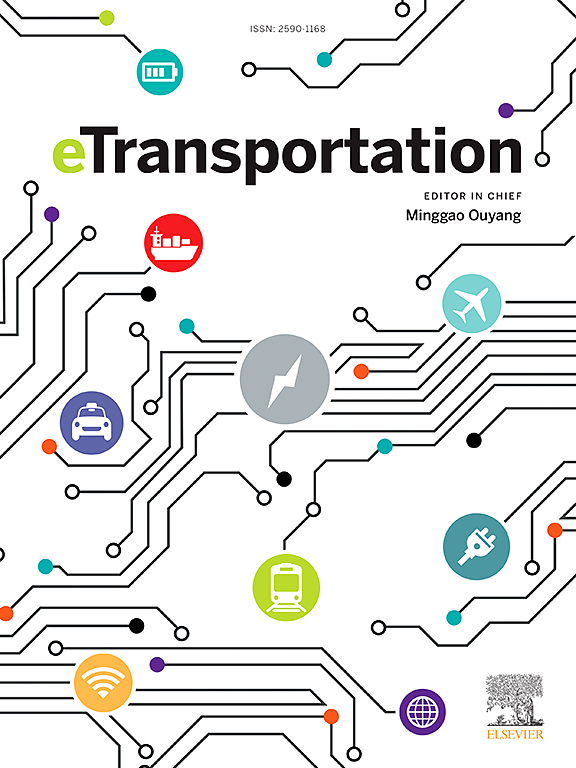利用阳极压降模型原位估计燃料电池系统中的氮浓度
IF 17
1区 工程技术
Q1 ENERGY & FUELS
引用次数: 0
摘要
优化氢供应控制是提高燃料电池系统效率和寿命的关键。氮通过膜的渗透会稀释氢浓度,增加氢饥饿的风险。然而,缺乏实时、经济有效的方法来监测或估计氮浓度,阻碍了优化氢利用和缓解氢饥饿的努力。为了解决这些问题,本研究建立了一个包含关键操作参数(包括氮浓度)的阳极压降模型。然后,在130 kW的全尺寸燃料电池系统上进行了一系列实验,在各种工况下对模型进行验证,利用超声波传感器测量氢气循环回路内的流量和气体浓度。最后,提出了一种基于该模型的氮浓度估计算法,并进行了实验验证。结果表明,在稳态和动态条件下,估计的氮浓度的平均绝对误差在1vol %左右。本文采用基于气体组成与粘度关系的机理模型来解释阳极压降与氮浓度的耦合变化。与现有方法相比,本文提出的氮浓度估计算法具有精度高、成本低、抗堆栈退化的鲁棒性,可以在控制器中实现原位氮浓度估计。这些进步实现了可预测的氢供应调节,有望提高系统的耐用性和效率。本文章由计算机程序翻译,如有差异,请以英文原文为准。

In-situ estimation of nitrogen concentration in fuel cell systems via anode pressure drop modeling
Optimizing hydrogen supply control is critical to enhancing the efficiency and lifespan of fuel cell systems. Nitrogen permeation across the membrane dilutes hydrogen concentration and increases the risk of hydrogen starvation. However, the absence of real-time, cost-effective methods to monitor or estimate nitrogen concentration hinders efforts to optimize hydrogen utilization and mitigate hydrogen starvation. To address these challenges, this study establishes an anode pressure drop model incorporating key operational parameters, including nitrogen concentration. Then, a series of experiments under various operating conditions are conducted on a 130 kW full-scale fuel cell system to validate the model, with the ultrasonic sensor employed to measure the flow rate and gas concentration within the hydrogen recirculation loop. Finally, a nitrogen concentration estimation algorithm based on the model is proposed and experimentally verified. Results demonstrate that the mean absolute error of the estimated nitrogen concentration is around 1 vol% under steady-state and dynamic conditions. This work employs a mechanistic model based on the relationship between gas composition and viscosity to elucidate the coupled variation of anode pressure drop and nitrogen concentration. Compared with existing solutions, the proposed nitrogen concentration estimation algorithm features high accuracy, low cost, and robustness against stack degradation, and can be implemented in controllers for in-situ nitrogen concentration estimation. These advancements enable predictive hydrogen supply regulation, which is anticipated to improve the system's durability and efficiency.
求助全文
通过发布文献求助,成功后即可免费获取论文全文。
去求助
来源期刊

Etransportation
Engineering-Automotive Engineering
CiteScore
19.80
自引率
12.60%
发文量
57
审稿时长
39 days
期刊介绍:
eTransportation is a scholarly journal that aims to advance knowledge in the field of electric transportation. It focuses on all modes of transportation that utilize electricity as their primary source of energy, including electric vehicles, trains, ships, and aircraft. The journal covers all stages of research, development, and testing of new technologies, systems, and devices related to electrical transportation.
The journal welcomes the use of simulation and analysis tools at the system, transport, or device level. Its primary emphasis is on the study of the electrical and electronic aspects of transportation systems. However, it also considers research on mechanical parts or subsystems of vehicles if there is a clear interaction with electrical or electronic equipment.
Please note that this journal excludes other aspects such as sociological, political, regulatory, or environmental factors from its scope.
 求助内容:
求助内容: 应助结果提醒方式:
应助结果提醒方式:


